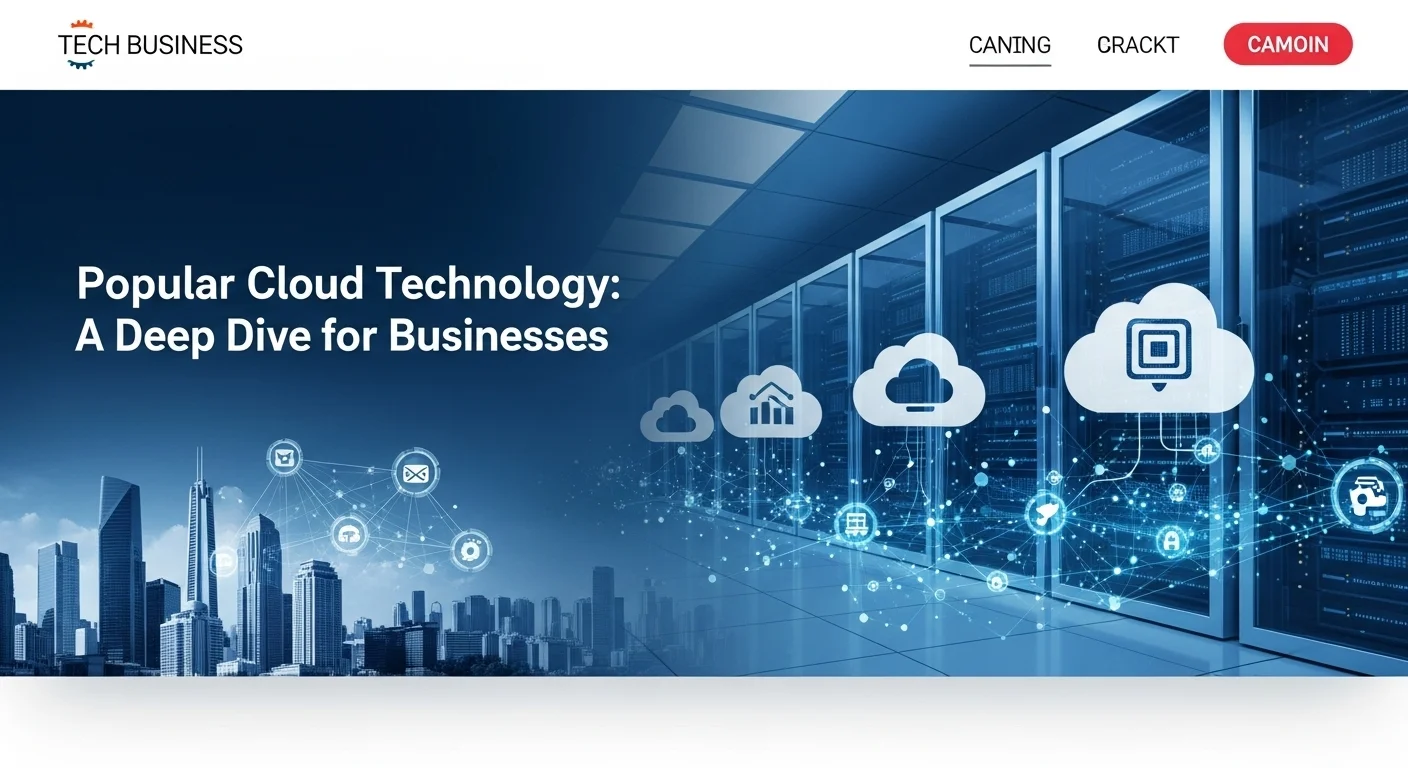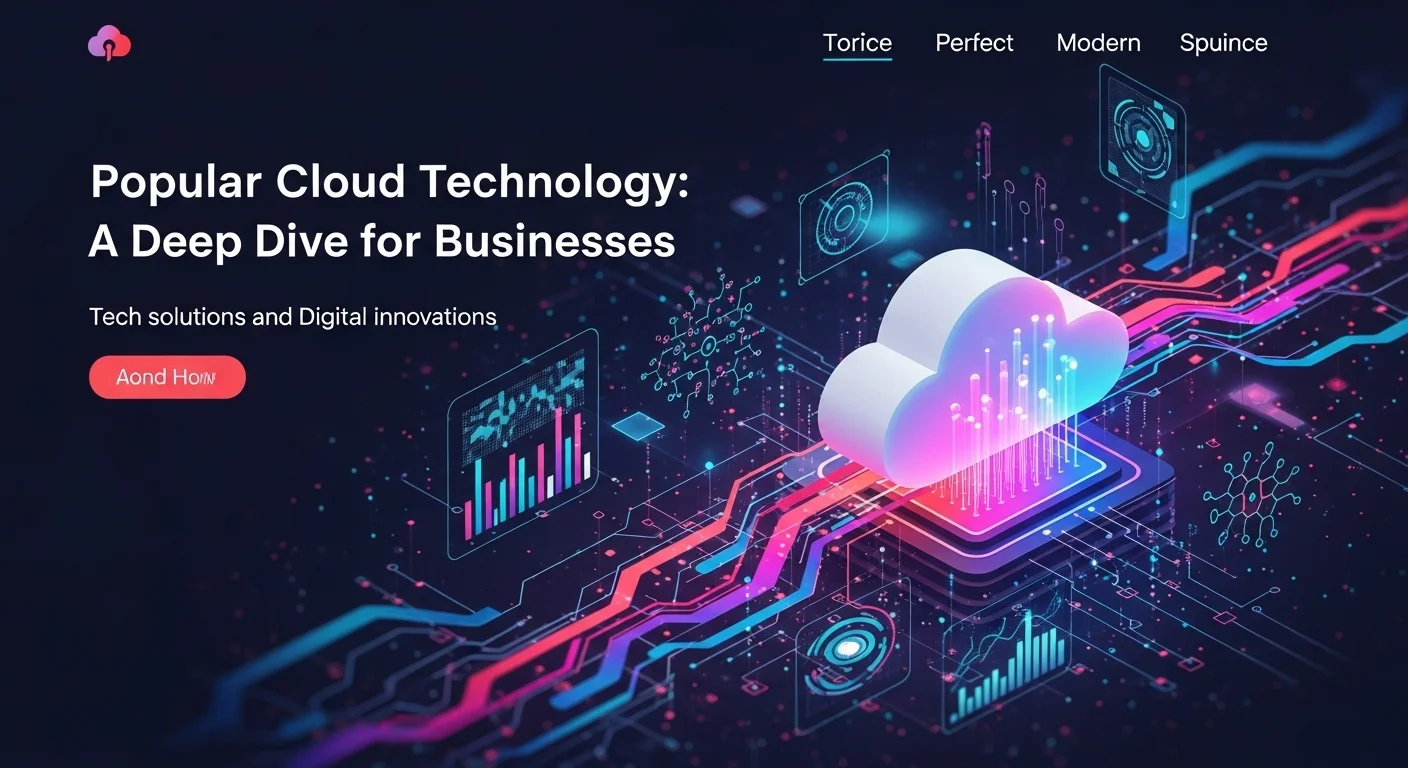Your Guide to Cloud Computing: How to Choose and Use the Best Cloud Services for Your Business

Executive Summary
In my 15 years as a cloud strategist, the most common question I get from business leaders isn't 'What is the cloud?' but 'What can the cloud do for *me*?' It's a landscape that seems complex, dominated by giants like Amazon Web Services (AWS), Microsoft Azure, and Google Cloud (GCP). But beneath the jargon lies a simple, powerful idea: accessing incredible computing power without the headache of owning the hardware. This guide is my attempt to cut through the noise. I'll walk you through what the cloud really is, introduce you to the major players as if we were choosing a car, and share practical strategies I've used to help businesses save money, innovate faster, and sleep better at night knowing their data is secure. This is the no-nonsense breakdown I wish I had when I started.
Table of Contents
Table of Contents
1. What Exactly Is 'The Cloud' and Why Should You Care?
2. The Core Components of Cloud Technology
2.1. Cloud Service Models: The Pizza Analogy (IaaS, PaaS, SaaS)
2.2. Deployment Models: Where Your Cloud Lives (Public, Private, Hybrid)
3. The Real-World Business Impact of the Cloud
What Exactly Is 'The Cloud' and Why Should You Care?
Let's forget the technical jargon for a moment. At its heart, 'the cloud' is simply someone else's computer. Instead of buying and maintaining your own expensive servers in a back room, you rent computing services—servers, storage, databases, software—over the internet from a massive, specialized company. The term 'cloud' became popular because early network diagrams used a cloud shape to represent the vast, complex network of the internet. It was a place where data went and came from, and you didn't need to know the messy details inside.
Why is this so important? I remember the 'old days' before the cloud became mainstream. If a company wanted to launch a new app, they had to spend tens of thousands of dollars on physical servers, wait weeks for them to be delivered, and hire a team to install and manage them. It was slow, expensive, and risky. If the app wasn't a hit, you were stuck with a room full of depreciating hardware. The cloud flipped that model on its head. It turned a huge capital expense (CapEx) into a predictable operational expense (OpEx), like a utility bill. This shift has been the single greatest democratizing force in technology, allowing a two-person startup to use the same world-class infrastructure as a Fortune 500 company.
The Core Components of Cloud Technology
To really get a handle on the cloud, you need to understand its building blocks. These are the service and deployment models that define how you interact with cloud resources.
Cloud Service Models: The Pizza Analogy (IaaS, PaaS, SaaS)
I've found the best way to explain the three main service models is through pizza. Everyone gets pizza.
- Infrastructure as a Service (IaaS): This is the 'Take and Bake' option. The cloud provider gives you the fundamental ingredients—the servers (oven), storage (fridge), and networking (kitchen). You are responsible for everything else: installing the operating system, managing the software, and securing your applications. It offers the most control and flexibility. Amazon Web Services (AWS) with its EC2 servers is the classic example. IaaS is perfect for companies migrating existing systems or those who need deep control over their environment.
- Platform as a Service (PaaS): This is like getting pizza delivered, but you add your own toppings at home. The provider manages the underlying infrastructure *and* the operating system, databases, and development tools. You just focus on building and running your application—your 'toppings.' Services like Google App Engine or Heroku fall into this category. PaaS is a developer's dream because it dramatically speeds up the process of building and deploying applications.
- Software as a Service (SaaS): This is dining out. You just show up and eat the pizza. You don't manage the kitchen, the oven, or even the recipe. Everything is handled for you. SaaS applications are the cloud services we use every day, like Google Workspace, Microsoft 365, or Salesforce. You access them through a web browser on a subscription basis. For businesses, SaaS eliminates all maintenance headaches.
Deployment Models: Where Your Cloud Lives (Public, Private, and Hybrid)
Beyond the service model, you decide *where* your cloud resources run.
- Public Cloud: This is the most common model, where you use the services of providers like AWS, Azure, or GCP. You share the overall infrastructure with other customers (called 'tenants'), but your data and applications are isolated and secure. The benefits are immense scale, no maintenance, and cost-effectiveness.
- Private Cloud: This is a cloud environment dedicated exclusively to your organization. You get maximum control and security, which is why it's often used by government agencies and financial institutions with strict compliance needs. It can be located on-site or hosted by a third party, but the hardware is all yours.
- Hybrid Cloud: This approach gives you the best of both worlds. It combines a private cloud with one or more public clouds, allowing data and apps to move between them. For example, you could keep your sensitive customer data in your private cloud while using the public cloud's powerful analytics tools to process it. I've seen this become the standard for most large enterprises I work with.
The Real-World Business Impact of the Cloud
The technology is cool, but the business results are what truly matter. Moving to the cloud isn't just an IT upgrade; it's a strategic move.
The most immediate benefit is cost savings. You stop guessing your capacity needs and paying for idle servers. You pay only for what you use, and the savings can be funneled back into growing the business. But it's more than that. It's about speed and agility. Need to test a new idea? You can spin up the necessary resources in minutes, not months. This allows you to innovate faster than your competitors.
Then there's scalability. I worked with an e-commerce client whose website used to crash every Black Friday. After moving to the cloud, their site could automatically scale to handle a thousand times the normal traffic and then scale back down when the rush was over. That's the power of elasticity.
Finally, there's the peace of mind that comes with enhanced collaboration and disaster recovery. Teams can work together from anywhere, and your data is often safer in a major cloud provider's network—replicated across multiple locations—than it ever was in your own server room. It's about building a more resilient, agile, and innovative business.

A Practical Guide to Today's Top Cloud Platforms and Services
Choosing a cloud provider can feel like choosing a car. They all get you from A to B, but they have different strengths, different feels, and are best suited for different kinds of drivers. Let's take a look under the hood of the 'Big Three'—AWS, Microsoft Azure, and Google Cloud Platform (GCP)—and break down the essential services that will power your business.
The Titans of the Cloud: A Head-to-Head Look
While there are many players, these three giants dominate the market. Understanding their personalities is key to making the right choice.
1. Amazon Web Services (AWS)
Think of AWS as the reliable, all-terrain SUV of the cloud world. It was the first to market back in 2006, and it has the largest market share and the most extensive list of services. If there's a computing task you can imagine, AWS probably has a service for it.
- Core Strengths: Its biggest strength is its maturity and breadth of services. Its core compute (EC2) and storage (S3) offerings are the industry standard. Because it's been around the longest, it has a massive community, extensive documentation, and a huge ecosystem of third-party tools that integrate with it.
- Who Should Use It: AWS is a fantastic all-rounder. It's great for startups that need to scale quickly, large enterprises migrating complex workloads, and pretty much everyone in between. If you want the widest array of tools and a proven, stable environment, AWS is a safe bet.
- A Word of Caution: The sheer number of options can be overwhelming, and its pricing can be complex. I've seen many companies get a shock when their first big bill arrives. You need to be diligent about cost management from day one.
2. Microsoft Azure
Azure is the sleek, corporate sedan that integrates perfectly with your existing professional life. As the second-largest player, Microsoft has brilliantly leveraged its deep roots in enterprise software.
- Core Strengths: Azure's superpower is its hybrid cloud capability. For companies that have decades of investment in on-premise Microsoft products (like Windows Server, Office 365, and Active Directory), Azure provides the smoothest on-ramp to the cloud. Services like Azure Arc let you manage both your on-premise and cloud resources from one place.
- Who Should Use It: Large enterprises, especially those already in the Microsoft ecosystem, will find Azure to be a natural fit. Its hybrid solutions are best-in-class for organizations planning a gradual migration.
- Considerations: While its service list is vast, some newer offerings may feel less mature than their AWS counterparts. It's catching up fast, but AWS still has the edge in sheer variety.
3. Google Cloud Platform (GCP)
GCP is the high-performance sports car, finely tuned for data, analytics, and cutting-edge tech. Google was a bit late to the cloud party, but it brought its A-game in the areas it knows best.
- Core Strengths: Google's DNA is in data, and it shows. GCP's services for big data (BigQuery) and machine learning/AI are widely considered the best in the business. It's also a leader in containerization with Kubernetes, which Google originally developed. Its global network is incredibly fast, and its pricing is often very competitive and user-friendly.
- Who Should Use It: Tech-forward companies, startups, and businesses whose success hinges on analyzing massive datasets will thrive on GCP. If you're building cloud-native applications or want to leverage powerful AI tools, GCP is a compelling choice.
- Considerations: Its market share is smaller, which means its global data center footprint and third-party ecosystem aren't as extensive as AWS or Azure.
Other Cloud Players to Watch
Beyond the Big Three, providers like Alibaba Cloud (a giant in Asia), Oracle Cloud (strong for existing Oracle database customers), and DigitalOcean (loved by developers for its simplicity and clear pricing) offer excellent, specialized alternatives.
Diving Deep into Essential Cloud Services
A provider is just a storefront; the services are the products on the shelves. Here are the categories you'll use most often:
- Compute Services: This is the engine. It's the raw processing power you rent, either as virtual machines (like a dedicated server in the cloud) or containers (lightweight, portable packages for your code).
- Serverless Computing: This is a revolutionary model. With services like AWS Lambda or Azure Functions, you just upload your code, and it runs automatically when triggered. You don't manage any servers, and you pay only for the milliseconds your code is running. It's incredibly efficient.
- Storage Services: Think of this as your infinite digital warehouse. You'll find different types for different needs, from object storage for files and media to high-speed block storage for your virtual machine hard drives.
- Database Services: One of my favorite cloud benefits. Instead of wrestling with database installation, patching, and backups, you can use a managed service. The cloud provider handles all the tedious administration, freeing up your team to focus on building great products.
- AI and Machine Learning Services: This is where the magic happens. The major providers offer powerful, pre-trained AI models for tasks like image recognition, text-to-speech, and language translation that you can easily integrate into your apps.
Smart Business Strategies for Cloud Adoption
Moving to the cloud requires a plan. You generally have a few options for migrating your existing applications:
- Rehost (Lift and Shift): The quickest route. You move your application to the cloud with minimal changes. It's fast, but you won't get all the cloud benefits.
- Replatform (Lift and Reshape): A middle ground. You make some small optimizations during the move to take advantage of cloud features, like using a managed database service.
- Refactor/Re-architect: The most involved, but most rewarding path. You fundamentally redesign your application to be 'cloud-native,' often using concepts like microservices.
Finally, embrace FinOps (Cloud Financial Operations). This is a cultural shift that brings financial accountability to the cloud's variable spending model. It involves tagging resources, monitoring costs closely, and continuously 'rightsizing' instances to ensure you're not paying for idle capacity. It's the key to making the cloud's economics work for you, not against you.

From Good to Great: Pro Tips for Mastering Your Cloud Environment
Getting your applications running on the cloud is the first step. Turning that setup into a secure, high-performing, and cost-effective engine for your business is the real goal. Over the years, I've seen what separates the companies that struggle with the cloud from those that thrive. It comes down to a few key disciplines. Here are my go-to strategies to help you master your cloud experience.
Fortifying Your Cloud: Essential Security Practices
Let's be clear: security isn't just a feature; it's the foundation. The major cloud providers have world-class security for their infrastructure, but they operate on a 'Shared Responsibility Model.' They secure the cloud; you are responsible for securing what's *in* the cloud. Here’s how:
- Master Identity and Access Management (IAM): This is your front door. Always follow the 'principle of least privilege'—give users and applications the absolute minimum permissions they need. And please, enforce Multi-Factor Authentication (MFA) on all accounts, especially administrative ones. It’s the single best thing you can do to prevent unauthorized access.
- Encrypt Everything: Assume your data will be targeted. Encrypt sensitive data both 'at rest' (when it's sitting in storage) and 'in transit' (when it's moving across the network). The tools for this are built-in and easy to use, so there's no excuse not to.
- Build Virtual Walls: Use tools like Virtual Private Clouds (VPCs) to create your own isolated slice of the cloud. Then, use security groups (like a firewall for your servers) to strictly control what traffic is allowed in and out.
- Use a Watchdog: Activate cloud-native monitoring services like AWS GuardDuty or Azure Sentinel. They use machine learning to constantly scan for suspicious activity and will alert you to potential threats before they become major problems.
Maximizing Performance While Managing Costs
An optimized cloud is fast for your users and lean on your budget. It's a balancing act achieved through good 'cloud hygiene.'
- Practice 'Rightsizing': The most common budget killer I see is overprovisioning—paying for a giant server when a small one will do. Regularly check your utilization metrics. If a server is consistently using only 10% of its CPU, shrink it down. Your wallet will thank you.
- Embrace Caching and CDNs: To make your application feel lightning-fast to users around the world, use a Content Delivery Network (CDN). A CDN stores copies of your content (like images and videos) in locations physically closer to your users, drastically reducing load times.
- Automate Your Scaling: Use autoscaling. This feature automatically adds servers when traffic is high and removes them when it's quiet. This ensures a great user experience during peak times without wasting money on idle capacity during off-hours. It’s the definition of cloud elasticity.
- Foster a FinOps Culture: Get your finance, development, and operations teams talking. When developers understand the cost implications of the resources they launch, they make smarter decisions. Use tags to assign every cloud cost to a specific project or team. This visibility is transformative.
Building for Resilience: How to Architect for High Availability
Your business can't afford downtime. The cloud gives you the tools to build systems that can withstand failures gracefully.
- Design for Failure: Don't hope components won't fail; assume they will. Build your application like a modern ship with watertight compartments. If one part fails, the rest of the system stays afloat.
- Go Multi-AZ: An Availability Zone (AZ) is a distinct data center. For any critical application, deploy it across at least two AZs in the same region. This way, if an entire data center has an issue, your application will keep running without interruption. This is the gold standard for high availability.
- Have a Tested Disaster Recovery (DR) Plan: Use automated services to back up your data regularly. For your most critical systems, create a plan to recover in an entirely different geographic region. Most importantly, *test this plan*. An untested backup is just a hope.
The Magic of Automation: Infrastructure as Code (IaC)
Manually clicking around a web console to set up your cloud environment is slow and prone to human error. The professional approach is Infrastructure as Code (IaC). This means defining all your cloud resources—servers, databases, networks—in code files.
- Why It's a Game-Changer: Using tools like Terraform or AWS CloudFormation, you create a blueprint of your infrastructure. This blueprint can be version-controlled (like your application code), reviewed, and reused. It lets you create identical development, staging, and production environments with the push of a button, ensuring consistency and dramatically speeding up deployments.
What's Next for the Cloud? Emerging Trends
- Generative AI Everywhere: AI is no longer just a service; it's being woven into the fabric of the cloud itself, helping to automate operations, write code, and uncover insights from data. Start exploring these tools to see how they can boost your team's efficiency.
- Multi-Cloud is the New Normal: More companies are strategically using services from multiple cloud providers to get the best tool for each job and avoid being locked into a single vendor.
- Green Cloud Computing: Sustainability is becoming a major focus. Providers are investing in renewable energy, and new tools are emerging to help you measure and reduce the carbon footprint of your cloud workloads.
- The Rise of the Edge: Edge computing is pushing cloud capabilities closer to where data is created, enabling ultra-low-latency applications for things like IoT devices and autonomous systems.
The cloud journey is an ongoing process of learning and refinement. By implementing these strategies, you can build a technological foundation that is not just a cost center, but a true driver of innovation and growth for your business. For staying on top of the latest industry news, I always recommend keeping an eye on publications like TechCrunch for their sharp analysis of the tech landscape.
Expert Reviews & Testimonials
Sarah Johnson, Business Owner ⭐⭐⭐
This was a solid overview, but as a small business owner, I was hoping for more relatable, day-to-day examples. The concepts are clear, but I'd love a case study on a company like mine.
Mike Chen, IT Consultant ⭐⭐⭐⭐
A really comprehensive guide. It helped connect the dots for me on the major platforms. Some of the deeper technical explanations could be a bit simpler, but overall, it's a great resource for consultants.
Emma Davis, Tech Expert ⭐⭐⭐⭐⭐
Absolutely fantastic article! As someone deep in the tech world, I appreciated the clarity and practical advice. It's a perfect resource for both newcomers and those looking to refine their cloud strategy. Bookmarked!



